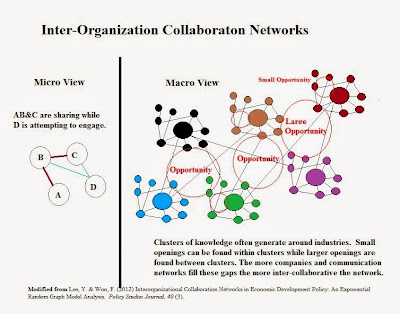Knowledge diffusion is naturally affected by the
quality of organizational information networks. These networks encourage the transference
and use of higher levels of information that impact the service functionality
of an organization. Dong, et. al. (2011) explores the need to understand these
networks, enhance them, and effectively use them to develop organizations.
Their explanation moves into the need to train workers on how to manage
information in order ensure that information resources are fully utilized.
Service and information systems are “value co-creation configurations of people,
technology, value propositions connecting internal and external service
systems, and shared information” (Maglio & Spohrer, 2008, pp. 18).
Organizations that use information properly can ensure that they are receiving
the right kind of information and putting that information to good use for service
effectiveness. Each network has inherent value fostered by their ability to
connect to rich elements within the internal or external environment.
The success of an organization is based both on its employee’s
talents and the way in which they interact (Hildalgo, 2011). Firms should
ensure that productive interaction is fostered for greater growth and knowledge
development. It is the process of obtaining information and applying it to
constructive projects that encourages productive use.
There are three major types of networks. Networks
can be random, small world, or clustered. Random networks are based in
knowledge intensive industries, small world networks are used in focused
intensive work environments, and clustered networks are common in organizations
where people form knowledge sharing cliques.
Developing industries need the larger random
networks to obtain enough information to develop multiple areas within an
industry. Organizations often cluster information based on how people relate to
each other and which group they identify with. Small world networks can be used
in inter or intra organizational development projects. Knowing which type of
network does which function is helpful in using them properly.
The researchers found that a stronger information
network model is helpful in formulating the effectiveness of structures. The way
in which information flows and is collected is important for overall utility. They
also believe that improving upon randomness to include additional information
into a more open system is beneficial for knowledge creation. Experienced
information and network users are able to capitalize on these networks for
growth but may need additional training to enhance skills.
Dong, S. et. al. (2011) A benchmarking model for
management of knowledge-intensive service delivery networks. Journal of Management Information Systems,
28 (3).
Hidalgo, C. (2011). The value in the links: Networks
and the evolution of organizations. In P. Allen, S. Maguire, and B. McKelvey (eds.), Sage
Handbook on Management and Complexity. London: Sage, 2011, pp. 257–569.
Maglio, P., and Spohrer, J. (2008). Fundamentals of
service science. Journal of the Academy of
Marketing Science, 36, (1). (Spring 2008)
